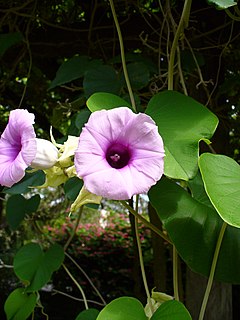
Argyreia is a genus of plants in the family Convolvulaceae.
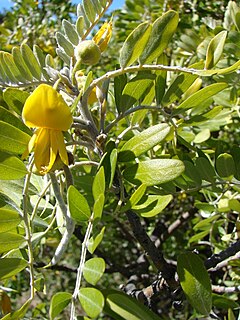
Sophora is a genus of about 45 species of small trees and shrubs in the pea family Fabaceae. The species are native to southeast Europe, southern Asia, Australasia, various Pacific islands, western South America, the western United States, Florida and Puerto Rico. The generic name is derived from sophera, an Arabic name for a pea-flowered tree.

Palaquium is a genus of about 120 species of trees in the family Sapotaceae. Their range is from India across Southeast Asia, Malesia, Papuasia and Australasia, to the western Pacific Islands.

Aquilaria is a genus of fifteen species of trees, called lign aloes or lign-aloes trees, in the family Thymelaeaceae, native to southeast Asia. They occur particularly in the rainforests of Indonesia, Thailand, Cambodia, Laos, Vietnam, Malaysia, Northeast India, Bangladesh, the Philippines, Borneo and New Guinea. The trees grow to 6–20 m tall. The leaves are alternate, 5–11 cm long and 2–4 cm broad, with a short acuminate apex and an entire margin. The flowers are yellowish-green, produced in an umbel; the fruit is a woody capsule 2.5–3 cm long.
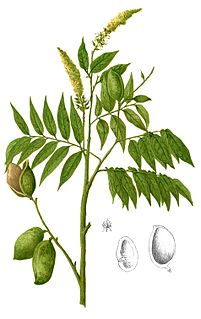
Crudia is a genus of plants in the family Fabaceae.
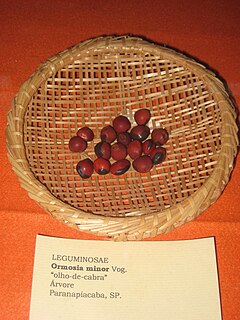
Ormosia is a genus of legumes. The more than 100 living species, mostly trees or large shrubs, are distributed throughout the tropical regions of the world, some extending into temperate zones, especially in East Asia. A few species are threatened by habitat destruction, while the Hainan Ormosia is probably extinct already.

Bhesa is a small genus of woody plants in the family Centroplacaceae. Its natural distribution is from southern China to New Guinea. It was formerly classified in Celastraceae, until a molecular phylogenetic study placed it in the family Centroplacaceae in the order Malpighiales.

Canthium is a genus of flowering plants in the family Rubiaceae. They are shrubs and small trees. The leaves are deciduous and the stems are usually thorny.

Gymnosporia is an Old World genus of plants, that comprise suffrutices, shrubs and trees. It was formerly considered congeneric with Maytenus, but more recent investigations separated it based on the presence of achyblasts and spines, alternate leaves or fascicles of leaves, an inflorescence that forms a dichasium, mostly unisexual flowers, and fruit forming a dehiscent capsule, with an aril on the seed.

Hopea is a genus of plants in the family Dipterocarpaceae. The genus was named after John Hope, 1725–1786, the first Regius Keeper of the Royal Botanic Garden, Edinburgh. It contains some 113 species, distributed from Sri Lanka and southern India to southern China, and southward throughout Malesia to New Guinea. They are mainly main and subcanopy trees of lowland rainforest, but some species can become also emergent trees, such as Hopea nutans.

Kokoona is a genus of plants in the family Celastraceae.

Madhuca is a genus of plants in the family Sapotaceae first described as a genus in 1791.
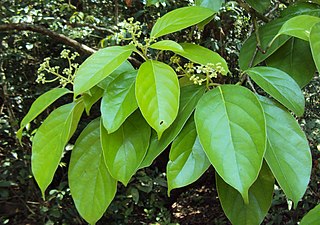
Mastixia is a genus of about 19 species of resinous evergreen trees, usually placed in the family Cornaceae. Its range extends from India through Southeast Asia and New Guinea to the Solomon Islands. Mastixia species have alternate or opposite simple broad leaves, many-flowered inflorescences, and blue to purple drupaceous fruits.
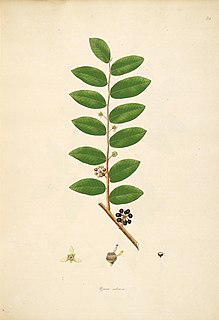
Polyalthia is a genus of flowering plants in the family Annonaceae. There are approximately 90 species distributed from Africa to Asia and the Pacific.

Salacia is a genus of plants in the family Celastraceae. They are woody climbers naturally found in tropical regions.
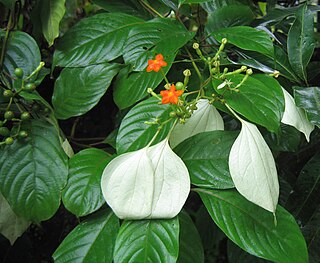
Mussaenda is a genus of flowering plants in the family Rubiaceae. They are native to the African and Asian tropics and subtropics. Several species are cultivated as ornamental plants.

Erycibe is a genus of plants in the family Convolvulaceae, found in the Andaman Islands, Sri Lanka, India including Assam, Bangladesh, Myanmar, east Himalaya, southern and southeastern China including Hainan and Taiwan, Southeast Asia, Malesia, Papuasia, Australia, and Japan including the Ryukyu Islands.

Loeseneriella is a genus of flowering plants belonging to the family Celastraceae.

















